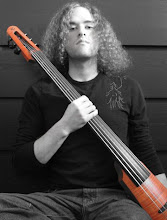It’s commonly believed in the electric string world that electric violinists should avoid using guitar amps. Apparently, the same trait that makes guitar solos sound “flashy” makes electric violins sound shrill and screechy. Well, not necessarily.
To demonstrate what I mean, I give you this video of electronica/progressive rock violinist James Sudakow playing with his band through a Marshall guitar amp. This song is called "Orange" from his album Green.
Goddamn right! I love this song and his sound.
Does he sound shrill and screechy through that amp? Not at all. In fact, his C string tone has some serious balls. Remember, guitar amps are the amps with the great tubes, and as guitarists have found, tubes are synonymous with good tone. So take advantage! If a problem with screeching does arise, well, that's why there's an equalizer on the amp.
Take note of what Sudakow is using in this video: a Zeta Strados 5-String Violin with the Strados Series Pickup and, according to his MySpace page, a Marshall JCM2000 TSL half stack. For a better look, his promo pictures give great close-ups of his gear. Unfortunately, his effects pedals aren't visible anywhere; I'd love to know what they are.
The Strados Pickup is worth mentioning because it's an active pickup (in contrast to a passive pickup) and can deliver a fat, low-impedance, noise-free signal to his effects and amp, which is always a plus. There's nothing wrong with passive pickups per se, but their signals are susceptible to RFI and sound a little weaker to me than active pickups' signals. If you have any thoughts about the two, feel free to leave a comment.
My point is: don't follow what people say, follow your ears. Electric string players have many, many options of pickups, instruments, bows, cables, amps, pedals, etc. available to use and it's up to them/us to put everything together and make a sound that evokes that devil inside (or some other feeling of satisfaction). Go play and listen to as much music as possible to teach your ears how active pickups sound versus passive ones, solid state amps versus tube amps, Yamaha Electric Instruments versus Mark Wood's instruments, etc, etc, etc. Only after discovering the possibilities and learning some basics about electronics can one truly "go out and get" the sound that's in one's head.
One last thing, I recommend that you check out James Sudakow post haste. He's great.









